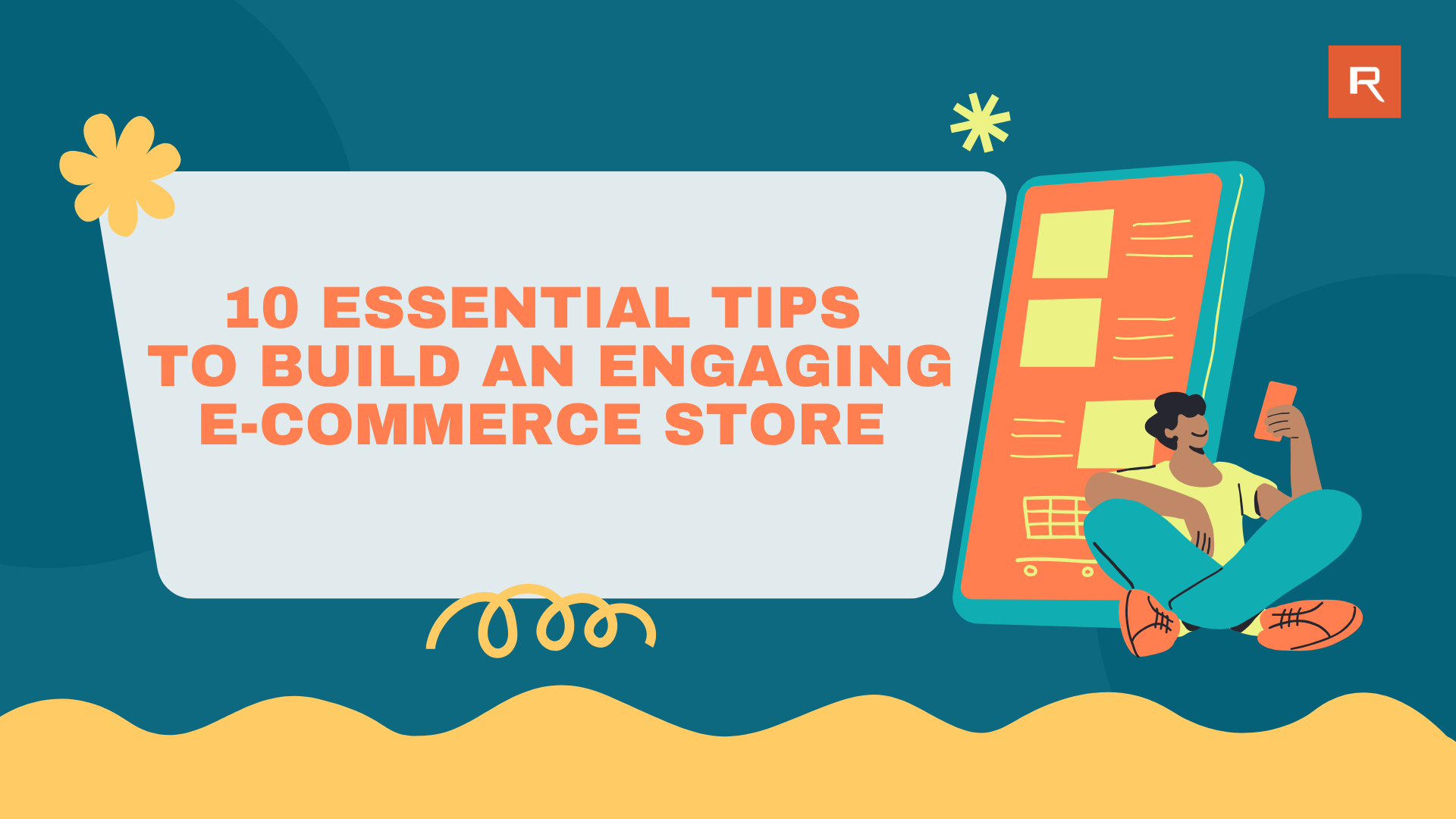
Live Chat

Domain Scan

(empty)

Login
10 Essential Tips to Build an Engaging E-commerce Store
(31-mar-2025)

In the rapidly evolving world of e-commerce, standing out is no longer an option it's a necessity. With the digital marketplace becoming increasingly crowded, creating an engaging online store is the key to attracting and retaining customers. In this comprehensive guide, we'll explore 10 powerful strategies to transform your e-commerce store into an engaging, conversion-driving powerhouse.
1. Leverage Advanced Personalization Techniques
Why This Matters
In an age where consumers are bombarded with generic marketing messages, personalization has become a critical differentiator. Personalization goes beyond addressing customers by their first name; it's about delivering content, product recommendations, and offers that are tailored to individual preferences and behaviors.
How to Implement
- AI and Machine Learning: Utilize AI algorithms to analyze customer data, such as browsing history, past purchases, and interaction patterns.
- Dynamic Content: Implement dynamic website content that changes based on who is visiting. For example, show different homepage banners to returning customers versus new visitors.
- Email Personalization: Send personalized email campaigns with product recommendations based on previous interactions.
- Segmentation: Segment your audience into distinct groups based on demographics, buying behavior, and engagement levels to tailor your marketing efforts effectively.
Action Tip: Use customer data to create hyper-personalized experiences, such as recommending products based on past purchases or offering exclusive discounts on items they've shown interest in.
2. Optimize for Voice Search
Why This Matters
With the proliferation of smart speakers like Amazon Echo and Google Home, voice search is becoming a significant channel for online shopping. Voice search queries are typically longer and more conversational, requiring a different SEO approach.
How to Implement
- Conversational Keywords: Incorporate long-tail keywords and phrases that match natural speech patterns.
- FAQ Pages: Create comprehensive FAQ sections answering common questions in a conversational tone.
- Structured Data Markup: Use schema markup to help search engines understand your content better.
- Local SEO: Optimize for "near me" searches if you have a physical presence or offer local services.
Action Tip: Update product descriptions and FAQs to include conversational phrases and questions, making it easier for voice assistants to find and present your content to users.
3. Utilize Video Marketing and Live Streaming
Why This Matters
Video content has emerged as one of the most engaging forms of media online. Videos can showcase products in a way that images and text cannot, providing a more immersive experience. Live streaming adds an element of immediacy and authenticity, allowing real-time interaction with your audience.
How to Implement
- Product Demonstrations: Create videos that demonstrate how your products work, highlighting key features and benefits.
- Behind-the-Scenes Content: Share videos that give customers a glimpse into your company's culture and processes.
- Customer Testimonials: Video testimonials can be more convincing than written ones.
- Live Q & A Sessions: Host live streams where customers can ask questions and receive immediate answers.
Action Tip: Host live streams on social media platforms like Facebook Live or Instagram Live to interact with your audience and demonstrate products in real-time, fostering a sense of community and trust.
4. Create High-Impact Visual Content
Why This Matters
Humans are visual creatures; High-quality visuals grab attention, convey professionalism, and can significantly influence purchasing decisions. In e-commerce, where customers can't physically touch or try products, visuals play a crucial role in bridging that gap.
How to Implement
- Professional Photography: Invest in high-resolution images that accurately represent your products.
- 360-Degree Views: Offer interactive 360-degree images to give customers a complete view of the product.
- Infographics: Use infographics to present information in an easily digestible visual format.
- Shoppable Images: Implement images where customers can click on a product within an image to go directly to the purchase page.
Action Tip: Use professional photography and consider interactive media like GIFs and shoppable videos to make your products more appealing and your site more engaging.
5. Enhance Mobile Shopping Experience
Why This Matters
A poorly optimized mobile site can lead to high bounce rates and lost sales. Mobile users expect fast loading times, intuitive navigation, and easy checkout processes.
How to Implement
- Responsive Design: Ensure your website adapts to various screen sizes and orientations.
- Simplified Navigation: Use a clean layout with easy-to-access menus and search functions.
- Mobile Payment Options: Integrate mobile wallets like Apple Pay and Google Wallet for faster checkouts.
- Accelerated Mobile Pages (AMP): Implement AMP to improve mobile page load speeds.
Action Tip: Regularly test your site's performance on various devices and browsers to identify and fix any mobile usability issues promptly.
6. Utilize Social Proof Strategically
Why This Matters
Social proof, a psychological phenomenon where people mimic the actions of others, is a powerful tool in influencing purchasing decisions. Showcasing positive experiences from other customers can build trust and credibility.
How to Implement
- Customer Reviews and Ratings: Display reviews and ratings prominently on product pages.
- User-Generated Content (UGC): Encourage customers to share photos or videos of them using your products.
- Testimonials: Feature testimonials from satisfied customers or influencers.
- Trust Badges and Certifications: Display any industry certifications or security badges to enhance credibility.
Action Tip: Highlight top reviews on product pages and encourage customers to share their purchases on social media using branded hashtags.
7. Streamline the Checkout Process
Why This Matters
A complicated or lengthy checkout process is a primary reason for cart abandonment. Simplifying the checkout process can significantly improve conversion rates and customer satisfaction.
How to Implement
- Guest Checkout Option: Allow customers to purchase without creating an account.
- Minimal Steps: Reduce the number of steps required to complete a purchase.
- Progress Indicators: Show customers where they are in the checkout process.
- Auto-Fill Forms: Use technology that auto-fills customer information to save time.
- Multiple Payment Options: Offer various secure payment methods, including credit cards, PayPal, and mobile wallets.
Action Tip: Regularly test the checkout process yourself to identify any potential friction points and gather feedback from customers on their experience.
8. Incorporate Chatbots for Instant Support
Why This Matters
Immediate assistance can make the difference between a sale and a lost customer. Chatbots provide 24/7 support, handling multiple inquiries simultaneously without the need for human intervention. They can answer frequently asked questions, assist with order tracking, and even guide users through the purchase process.
How to Implement
- AI-Powered Chatbots: Implement chatbots that use natural language processing to understand and respond to customer inquiries effectively.
- Multichannel Support: Deploy chatbots across your website, mobile app, and social media platforms.
- Seamless Handover: Ensure complex issues can be escalated smoothly to human customer service agents.
- Personalization: Program chatbots to personalize interactions based on user data.
Action Tip: Monitor chatbot interactions to continually improve responses and ensure they provide accurate and helpful information.
9. Optimize for Local SEO
Why This Matters
If your e-commerce business serves specific regions or has physical locations, local SEO helps you appear in location-based searches. This is particularly important for searches with local intent, such as "electronics store near me" or "best boutique in [city]."
How to Implement
- Google My Business: Create and optimize your Google My Business listing with accurate contact information, hours of operation, and high-quality images.
- Local Keywords: Incorporate local keywords into your website content and metadata.
- Customer Reviews: Encourage local customers to leave reviews on your Google My Business listing.
- Local Backlinks: Build relationships with local businesses and organizations for backlink opportunities.
Action Tip: Add local schema markup to your site to enhance your visibility in local search results and appear in features like Google's Local Pack.
10. Engage with Interactive Content
Why This Matters
Interactive content increases engagement by requiring active participation from users. This not only keeps visitors on your site longer but also provides valuable insights into their preferences and behaviors.
How to Implement
- Quizzes and Surveys: Create quizzes that help customers find products that suit their needs or gather feedback.
- Interactive Guides: Develop interactive product guides or comparison tools.
- Contests and Giveaways: Host interactive contests that encourage sharing and engagement.
- Calculators: Provide calculators (e.g: for pricing, sizing) to assist in the decision-making process.
Action Tip: Use the data collected from interactive content to refine your marketing strategies and personalize future customer interactions.
Bonus Tip: Integrate with Social Commerce
Why This Matters
Social media platforms are increasingly offering integrated shopping experiences. Social commerce allows customers to discover and purchase products without leaving their favorite social apps, reducing friction and capitalizing on impulse buying behavior.
How to Implement
- Shoppable Posts: Use features like Instagram Shopping and Facebook Shops to tag products in your posts.
- Influencer Partnerships: Collaborate with influencers to showcase your products to a broader audience.
- Social Media Ads: Run targeted advertising campaigns with direct links to product pages.
- Engaging Content: Create shareable content that encourages user interaction and extends your reach.
Action Tip: Regularly update your social media catalogs and ensure synchronization with your inventory to prevent overselling.
Conclusion
By implementing these innovative strategies, your e-commerce store will not only attract more visitors but also convert them into loyal customers. The key is to create a seamless, personalized, and engaging shopping experience that meets the evolving expectations of today's consumers.
Remember, the digital landscape is ever-changing, and staying ahead means continuously adapting and embracing new technologies. Regularly analyze your store's performance, gather customer feedback, and be willing to experiment with new approaches.
Next Steps with Register.lk
At Register.lk, we understand the importance of a strong online presence. Whether you're launching a new e-commerce site or looking to enhance your existing one, our comprehensive domain and hosting solutions are designed to support your growth every step of the way.
Ready to elevate your e-commerce game? Contact Register.lk today and transform your online store into a customer engagement powerhouse.
 Written by: Register.lk Support Hero - Kesaru
Written by: Register.lk Support Hero - Kesaru











